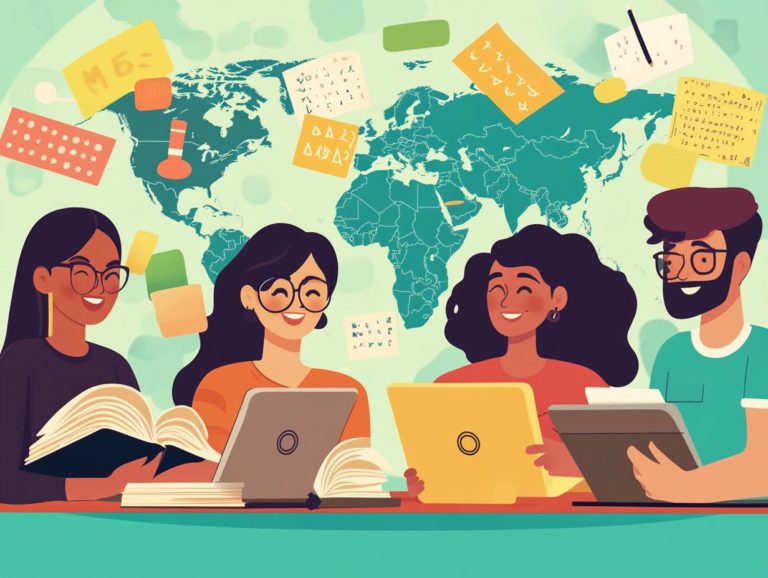the role of repetition in language acquisition
Language acquisition is a fascinating journey. One of the most powerful tools at your disposal is repetition.
Repetition plays a crucial role in how you learn and retain new languages. It influences everything from your memory to your pronunciation. This discussion delves into the significance of repetition and uncovers how it enhances your fluency and retention.
You’ll discover effective strategies for incorporating repetition into your language lessons, along with insights into cultural nuances that can shape your approach.
Embark on this exploration of mastering a new language through the transformative power of repetition.
Contents
- Key Takeaways:
- The Importance of Language Acquisition
- How Repetition Affects Language Learning
- Improving Pronunciation and Fluency
- Effective Strategies for Using Repetition
- Incorporating Repetition in Language Lessons
- Using Technology for Repetition Practice
- The Role of Culture in Repetition
- Cultural Differences in Language Learning
- Frequently Asked Questions
- What is the role of repetition in language acquisition?
- How does repetition aid in language acquisition?
- Is repetition the only method for language acquisition?
- What are some strategies for incorporating repetition in language acquisition?
- At what age is repetition most effective for language acquisition?
- How does the role of repetition change as language proficiency increases?
Key Takeaways:

Repetition is vital in language acquisition. It improves memory and retention of new words and concepts. Incorporating repetition in language lessons and utilizing technology for practice significantly enhances pronunciation and fluency. Consider how culture affects your language learning, as different cultures may have varying approaches and preferences for repetition techniques.
The Importance of Language Acquisition
Language acquisition is the cornerstone of effective learning. It profoundly shapes your ability to communicate, comprehend, and connect with diverse cultures and societies.
By exploring the mechanisms of language acquisition, you can refine your teaching and learning approaches, unlocking new pathways for engagement.
It involves not just mastering vocabulary and pronunciation but also developing thinking skills essential for navigating complex language structures.
As educational institutions align with the evolving needs of language learners, focusing on structured learning environments and effective strategies becomes essential for your success.
Why Repetition is Essential
Repetition is crucial in your learning journey, enhancing memory retention and strengthening neural connections, making it easier to recall information later.
By consistently engaging with the material, you reinforce your understanding and build a solid foundation for grasping complex concepts. This approach is especially beneficial in language acquisition, where daily vocabulary drills can significantly accelerate your fluency.
Using tools like flashcards allows you to test your recall frequently. Spaced repetition systems optimize your review timing to match different memory retention spans.
These strategies show that consistent practice boosts your memory and maximizes your cognitive resources, facilitating a smoother transition from short-term recall to long-term understanding.
How Repetition Affects Language Learning
Repetition is key in your language learning journey. It significantly enhances both memory and retention.
It’s one of the most effective strategies for mastering a new language. Embracing this technique can transform your learning experience, allowing you to internalize concepts and vocabulary with greater ease.
Memory and Retention

Memory retention is vital in language acquisition. It directly influences how well you can recall vocabulary and language structures over time.
Understanding memory mechanisms can elevate your language learning experience. Retention intervals are crucial; without reinforcement, your brain’s ability to store and recall information fades over time.
This is where spaced repetition shines. Reviewing material at spaced intervals boosts long-term retention and reinforces your learning pathways.
You can use various methods, such as flashcards, quizzes, and mnemonic devices, to engage actively with the material. This enhances your thinking skills and strengthens your ability to retrieve and apply your language knowledge effectively.
Improving Pronunciation and Fluency
Improving your vocabulary pronunciation and fluency in a new language often hinges on structured practice and the strategic use of repetition techniques. This approach helps you better understand sounds and patterns, resulting in smoother speech.
As you engage with new vocabulary, it s essential to recognize linguistic patterns, such as syllable stress and intonation, which can significantly influence meaning. A supportive learning environment is vital; it allows you to practice freely without the fear of making mistakes.
For example, you might dedicate practice sessions to reading aloud or engaging in role-playing exercises, where you repeat phrases multiple times. This method boosts your vocabulary and empowers you to speak confidently!
Effective Strategies for Using Repetition
To master the art of language learning, you ll find that effective strategies often combine both traditional and modern educational methods. This blend engages you and deepens your understanding, making the process more enriching and enjoyable.
Incorporating Repetition in Language Lessons
Incorporating repetition into your language lessons demands a careful approach that balances curriculum requirements while prioritizing comprehension skills. You can employ various strategies to seamlessly integrate repetition into your lessons without overwhelming your students.
For instance, utilizing thematic units allows you to revisit vocabulary and structures across different contexts, enhancing retention. Engaging activities such as language games or role-plays invite repeated practice in an enjoyable manner.
Imagine a lesson plan centered around storytelling, where students listen to, read, and then retell the same story multiple times, gradually increasing their involvement. This technique not only reinforces vocabulary but also builds their confidence in speaking skills, effectively navigating challenges posed by stringent curriculum demands.
Using Technology for Repetition Practice

Utilizing technology for repetition practice can significantly elevate your learning experience. It provides a range of educational tools and interactive games designed to reinforce your language skills.
These resources include sophisticated learning management systems and advanced spaced repetition software, which helps you review material over increasing intervals of time to aid memory. They create personalized learning pathways that adapt to your individual progress.
By employing algorithms that optimize review timing, these systems ensure that critical vocabulary and grammar points are revisited at intervals that promote long-term retention.
Interactive games not only inject fun into your practice but also spark a competitive spirit among your peers, transforming practice from a tedious task into an engaging challenge. Start using technology today to supercharge your learning!
The Role of Culture in Repetition
The role of culture in repetition is profoundly significant. Cultural differences can deeply shape how repetition techniques are perceived and applied in language learning.
Understanding these nuances allows for a more tailored and effective approach, ensuring that methods resonate with learners on a personal level.
Cultural Differences in Language Learning
Cultural differences in language learning significantly impact your engagement and the effectiveness of repetition techniques employed in various educational frameworks.
In some cultures, collaborative learning takes center stage, allowing students to thrive through group discussions and peer interactions. In contrast, other cultures might lean toward individual learning methods that promote self-study and introspection.
These differing preferences shape how repetition techniques are perceived. In more collective cultures, engaging in repetitive drills might be far more effective when woven into team activities rather than presented in isolation.
To enhance your engagement as a learner, educators can adapt their strategies by incorporating culturally relevant materials, cultivating a supportive environment that encourages sharing, and recognizing the diverse backgrounds you bring to the language learning journey.
By customizing these approaches, educators can create more inclusive and effective learning experiences that truly resonate with the rich tapestry of cultural perspectives you represent.
Adapting Repetition Techniques for Different Cultures
Adapting repetition techniques to suit different cultures is crucial for achieving meaningful success in language learning. It takes into account the unique cultural contexts of each learner.
This approach not only enhances comprehension but also fosters engagement and respect for the diverse backgrounds that enrich the learning experience.
For example, weaving in storytelling from various cultures can transform repetitive practice into something far more relatable. Utilizing visual aids or culturally relevant examples further bridges gaps in understanding.
Engaging in group activities that celebrate cultural nuances allows learners to collaborate and share their distinct perspectives. This creates a more inclusive learning environment.
These tailored strategies improve retention and build confidence, encouraging students to participate more actively in their language journey.
Frequently Asked Questions

What is the role of repetition in language acquisition?
The role of repetition in language acquisition is to help learners internalize and retain new language skills. Repetition allows learners to become more familiar with the language and its patterns, making it easier for them to understand and produce language.
How does repetition aid in language acquisition?
Repetition aids in language learning by reinforcing the pathways in the brain responsible for language processing. This helps learners develop smooth use of language and improves their overall fluency and accuracy.
Is repetition the only method for language acquisition?
No, repetition is not the only method. While it is an important component, it is best used in combination with other methods such as immersion, meaningful communication, and exposure to authentic materials. These methods help learners develop a more well-rounded understanding and use of the language.
What are some strategies for incorporating repetition in language acquisition?
There are various strategies for incorporating repetition, such as using rote learning techniques, practicing through drills and exercises, reviewing previously learned material, and engaging in conversational practice with native speakers. It is important to find a balance between repetition and other methods for effective language learning.
At what age is repetition most effective for language acquisition?
Repetition works wonders for every age group! It can be effective at any age but is most influential during early childhood when the brain is still developing and more receptive to language learning. However, it is never too late to use repetition, and it can still benefit adults as well.
How does the role of repetition change as language proficiency increases?
As language proficiency increases, the role of repetition shifts from introducing new language skills to reinforcing and fine-tuning existing ones. Repetition helps maintain language abilities and allows learners to continue expanding their vocabulary, grammar, and fluency. It can also help improve complex language skills such as understanding and producing idiomatic expressions and colloquial language.






